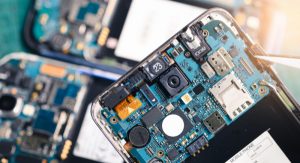
A research project led by The University of Edinburgh (UoE) has transformed the efficiency of modem chips used in smartphones and Internet of Things (IoT) devices around the globe.
The benefits of this innovation are being enjoyed by consumers across the planet as it’s led to significantly improved battery life within smartphones and enabled these devices to manage the extra demands required for 5G technology.
Building on more than 15 years of research into the software tools supporting the modem chips that power smart devices, the University’s Compiler and Architecture Design (CArD) group formed a collaboration with Qualcomm, global leaders in processor manufacturing and one of the world’s leading suppliers of smartphone processors. Qualcomm holds a 40% share of market valued at $4.8 billion with a client list that includes Apple, Samsung and Motorola.
The project, focused on reducing the required code size for modem and Wi-Fi chipsets, was led by Dr Björn Franke of the University’s CArD group. The team also included UoE PhD student Tobias Edler von Koch, as well as Pranav Bhandarkar and Anshuman Dasgupta from Qualcomm’s Innovation Center.
The group developed a ‘compiler pass’ solution after identifying a number of ways to improve on existing software engineering practices used within chip manufacturing. Their key discovery, that many functions could be merged, enabled the team to significantly reduce code size to levels that were not previously achievable.
The solution developed by the UoE-led team was truly ground-breaking, as it maintained the functionality and performance of smartphone of IoT devices without requiring any additional custom hardware.
Adapting this innovation led to a 12% reduction in code size within Qualcomm’s firmware. It is now used within the company’s software kit that is contained within billions of cellular and WiFi modems in IoT devices, smartphones and tablets.
The UoE-led innovation has generated major cost savings for Qualcomm and has enhanced the company’s position within the global marketplace. Qualcomm praised the UoE research team, saying their solution directly translated into significant cost savings for their modem and chip manufacturing. Seven years after adopting this solution within their manufacturing processes, Qualcomm has become a major player in its market. In 2019 the company announced it was shipping 1,000,000 modem chips per day for IoT devices alone.
Along with the commercial advantages for Qualcomm and its clients, the legacy of the University’s research has also brought distinct benefits for people who use billions of smart devices across the world. The significant improvements in functionality that were made possible thanks to the work of Dr Franke and his team have brought major improvements in 5G technology. Because 5G requires a larger memory footprint compared to its predecessors, the UoE-led code reduction solution has enabled extra capacity without increasing the chip size. For consumers this means cheaper devices with increased battery life.
Little wonder that it was estimated in 2020 that UoE technology was now employed in over 175,000,000 5G handsets alone.
Project leader Dr Björn Franke said:
It has been satisfying to work with the dynamic team from Qualcomm Innovation Center, solving a hard, real-world problem and contributing to the advancement of state-of-the-art communications technology.”
Work with the School of Informatics


